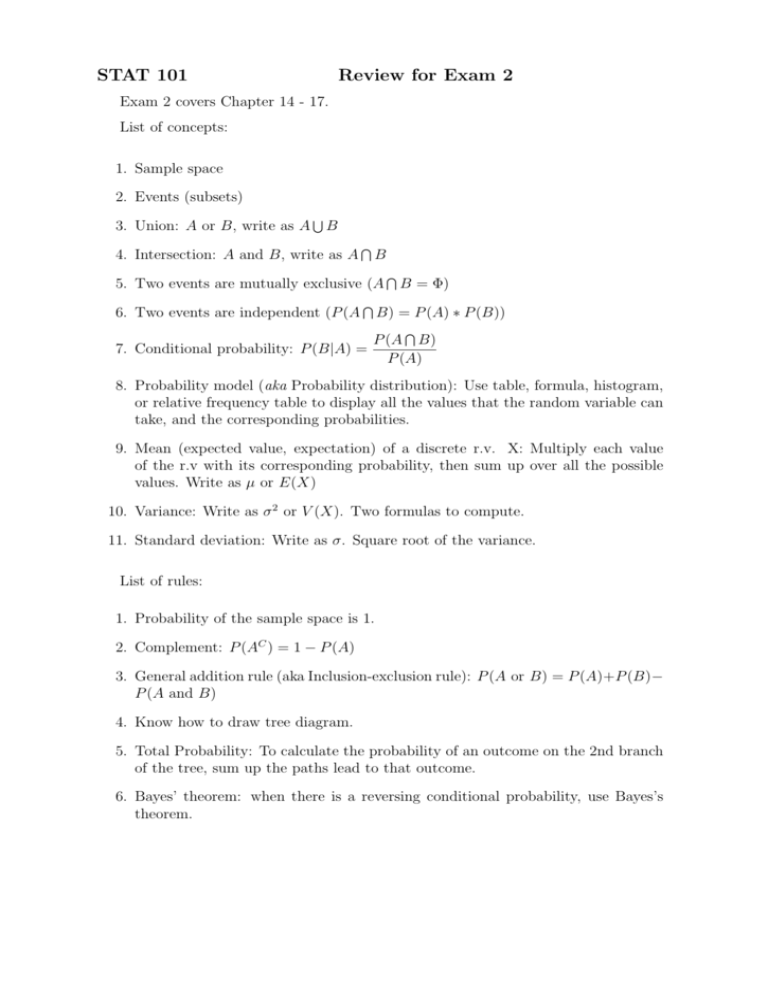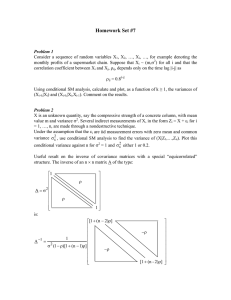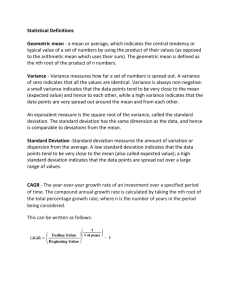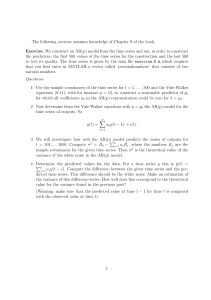STAT 101 Review for Exam 2
advertisement

STAT 101 Review for Exam 2 Exam 2 covers Chapter 14 - 17. List of concepts: 1. Sample space 2. Events (subsets) 3. Union: A or B, write as A S B 4. Intersection: A and B, write as A T B 5. Two events are mutually exclusive (A 6. Two events are independent (P (A T T B = Φ) B) = P (A) ∗ P (B)) T P (A B) 7. Conditional probability: P (B|A) = P (A) 8. Probability model (aka Probability distribution): Use table, formula, histogram, or relative frequency table to display all the values that the random variable can take, and the corresponding probabilities. 9. Mean (expected value, expectation) of a discrete r.v. X: Multiply each value of the r.v with its corresponding probability, then sum up over all the possible values. Write as µ or E(X) 10. Variance: Write as σ 2 or V (X). Two formulas to compute. 11. Standard deviation: Write as σ. Square root of the variance. List of rules: 1. Probability of the sample space is 1. 2. Complement: P (AC ) = 1 − P (A) 3. General addition rule (aka Inclusion-exclusion rule): P (A or B) = P (A)+P (B)− P (A and B) 4. Know how to draw tree diagram. 5. Total Probability: To calculate the probability of an outcome on the 2nd branch of the tree, sum up the paths lead to that outcome. 6. Bayes’ theorem: when there is a reversing conditional probability, use Bayes’s theorem. 7. Read a story, know how to write down the probability model, compute the mean, variance and standard deviation. 8. Linear combination of independent random variables: Expecation is linear: E(aX + bY ) = aE(X) + bE(Y ). e.g: E(2X − 3Y ) = 2E(X) − 3E(Y ) Variance is not linear: V (aX + bY ) = a2 V (X) + b2 V (Y ). e.g: V (2X − 3Y ) = 4V (X) + 9V (Y ) To compute standard deviation of a r.v, always compute the variance, then take a square root. 9. Special distributions: • Geometric distribution (model): X= the number of tosses until the 1st heads. If P (H) = p, P (T ) = q, P (X = k) = q k−1 p, k = 1, 2, 3, ... • Binomial distribution: Y = the number of heads out of n tosses. If P (H) = p, P (T ) = q, P (Y = k) = nCkpk q n−k , k = 0, 1, 2, ..., n. The mean E(Y ) = np. Variance V (Y ) = npq. • Poisson Model: Counting number of occurrences pdf: P (X = k) = 0, 1, 2, ... The mean and variance are both λ e−λ λk ,k= k!











